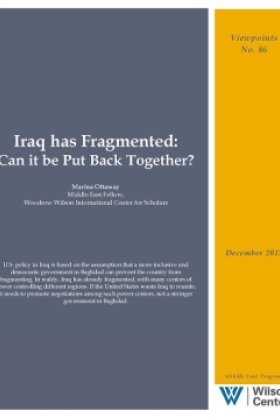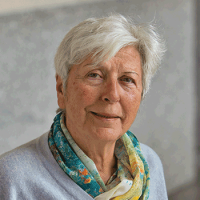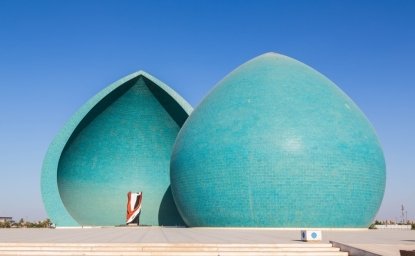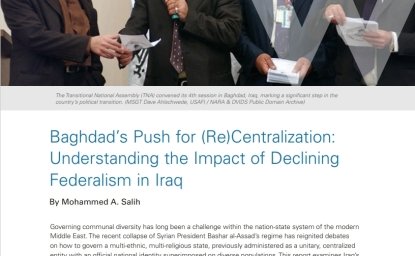Iraq has Fragmented: Can it be Put Back Together?


The Islamic State of Iraq and the Levant (ISIL) has lost control of the town of Sinjar and an important segment of the highway connecting Raqqa in Syria to Mosul in Iraq. If consolidated, this will be a significant loss for ISIL, making communications between its territories in Syria and Iraq more difficult. But ISIL’s loss is not Baghdad’s victory. The battle was waged by the Kurdish peshmerga and the president of the Kurdistan region, Masoud Barzani, initially declared that only the Kurdish flag would fly over liberated Sinjar, although he eventually allowed an Iraqi flag to be hoisted. That declaration sums up the extent of Iraq’s disintegration.
Despite clear evidence that Baghdad has no control over the country, the United States is reluctant to admit that this is the case and is instead pursuing a policy to prevent Iraq from fragmenting. The reluctance is understandable, but a policy based on fiction is bound to fail. The challenge now is not to prevent fragmentation but to promote a degree of reintegration. This is not a matter of semantics: a policy based on promoting reintegration would differ significantly from the present one.
Present policy is directed at strengthening the Iraqi military by providing weapons and training so it can fight ISIL more effectively and regain control over the entire country, while at the same time convincing the government in Baghdad to become more inclusive, less corrupt, and more responsive to its citizens. It is, in other words, the policy the United States followed with little success all along. The policy is even less likely to work now, because numerous centers of power have consolidated and the Iraqi government is only one such center. It does not have the raw power it would need to eliminate other autonomous centers—it cannot force the peshmerga to hand over Sinjar, for example—and has little to offer that would convince any group to submit to central authority.
Baghdad has not governed the three provinces in the northeast that form the Kurdistan region since the United States imposed a no-fly zone in 1991. The constitution of 2005 recognized Kurdistan as a region with a high degree of autonomy. The last major tie between Iraq and Kurdistan—the latter’s financial dependence on revenue transfers from Baghdad—was effectively severed by Prime Minister Nouri al-Maliki’s decision to stop paying to Kurdistan the funds it owed and then by the Kurds’ decision to export their oil directly and keep the revenue.
The area under the control of the Kurdistan Regional Government (KRG) has expanded significantly since ISIL seized control of Mosul and parts of Nineveh province during the summer of 2014. The KRG moved quickly to defend or to liberate from ISIL not only territory that is officially part of the Kurdistan region, but also the disputed areas on its perimeter, including Kirkuk and its oil fields. The KRG now controls much of the disputed areas—and most of what it does not control is in the hands of ISIL, not of Baghdad. Kurdistan does not want a more inclusive or less corrupt government in Baghdad; it wants independence. The only deal that might dissuade it from that goal is a further weakening of the central government that gave Erbil total control over its internal affairs and finances—in other words, the transformation of Iraq into a loose confederation of self-governing parts.
Baghdad also has lost control over large parts of the predominantly Sunni provinces, large swaths of which are occupied by ISIL. Ever since the fall of Saddam Hussein in 2003, Sunnis have been seething with discontent over their perceived lack of influence and domination by the Shi’a majority. Sunni parties resented the 2005 constitution and its federal provisions, complaining it was drafted without adequate Sunni participation. Discontent further increased after Maliki became prime minister in 2010, for a second term, continuing the de-Ba’athification policy that affected Sunnis disproportionately, ignoring popular protests, and forcing prominent Sunni politicians out of power and in some cases into exile. Sunni resentment, however, did not translate into clear, unequivocal demands. At first, they favored a strong central state, deluding themselves that they could be a dominant voice in it. But by 2012, some were coming to the conclusion that greater autonomy might be the best way to protect their interests. The provincial councils of Sunni majority provinces voted to form regions as allowed by the constitution, but Maliki did not allow the process of transformation to go ahead.
Sunni discontent helped open the door to radical Islamists. Under the U.S. occupation, Anbar province had been the stronghold of al-Qaeda in Iraq. While the grip of the organization was broken by the surge in the number of U.S. troops and the organization of Sunni militias of the Sahwa in 2007, the fundamental problem of Sunni discontent was not addressed and flared up again as the United States scaled back its presence and finally withdrew all its troops. Maliki stopped paying the militias, was antagonistic to Sunni politicians, and turned a deaf ear to popular grievances. Radical Islamists resurfaced, no longer as al-Qaeda but as the Islamic State of Iraq and the Levant (ISIL), and terrorist attacks spiked again. In January 2014, ISIL changed its tactics from employing hit-and-run attacks on small towns and villages to occupying large population centers, starting with Fallujah and Ramadi in Anbar province and continuing with Mosul, much of Nineveh province, and the rest of Anbar province, as well as parts of Salahuddin and Diyala. ISIL even came close to invading Erbil and Kirkuk until it was stopped by Kurdish resistance and U.S. bombing.
The government in Baghdad, seen as Shi’a dominated by Sunnis and Kurds, in reality has to compete with other centers of power even in Shi’a provinces. Religious authorities, above all Ayatollah Ali al-Sistani, have a great deal of authority; the most powerful Shi’a militias fighting ISIL, collectively known as al-Hashd al-Shaabi (or Popular Mobilization Forces), are funded, armed, and controlled by Iran; and even political authorities in many Shi’a provinces resent the control of Baghdad, particularly over their finances. Adding to the difficulties of the government, the position of current Prime Minister Haider al-Abadi is tenuous. The Shi’a parties are divided among themselves and many still favor former Prime Minister Nouri al-Maliki.
There is a glaring mismatch between the United States’ claim—that an inclusive, reformist government in Baghdad could bring the fragmented country together—and the real situation. Iraq is not composed of individual voters ready to embrace a central government acting democratically, putting behind them all other considerations. And the issues are not just sectarian and ethnic identities. The issue is the large number of organized centers of power and authority with their own agendas, in many cases backed up by their own military organizations. There is a Kurdistan region where rival political parties backed by militias are vying for power. There are Sunni areas where tribal militias, elements of the Saddam Hussein regime, elected provincial authorities, and government officials try to occupy whatever space ISIL does not control. There are Shi’as in militias directed by Iran, others who pay allegiance to Ayatollah al-Sistani, provincial councils who want more power, and at least one provincial governor, in Basra, who hints at seceding from the country. The question is not whether such goals and demands are realistic, or good for the country or for outside actors. The issue is that these competing forces have some backing and are not going to disappear in the name of an inclusive government, even if one emerged.
The survival of Iraq will depend on whether some of these power centers, most notably ISIL, can be defeated militarily and whether others prove willing to negotiate a compact that allows them to remain part of a single country. The United States has to refocus its political agenda in Iraq on the task of helping the parties reach a new agreement on what they want the country to be, and that requires admitting that the Iraq the United States intended to build never came into existence and never will. Helping Iraqis reimagine their country is going to become even more important as the fight against ISIL intensifies with international support now that the organization has declared itself to be a global threat. Even if ISIL was dislodged from the entire country, as it was dislodged from Sinjar, ISIL’s defeat would not turn into a victory for Iraq.
The opinions expressed herein are those of the author and do not reflect those of the Wilson Center.
Author

Former Senior Research Associate and Head of the Middle East Program, Carnegie Endowment for International Peace

Middle East Program
The Wilson Center’s Middle East Program serves as a crucial resource for the policymaking community and beyond, providing analyses and research that helps inform US foreign policymaking, stimulates public debate, and expands knowledge about issues in the wider Middle East and North Africa (MENA) region. Read more

Explore More
Browse Insights & Analysis
Iraq Should Consider Extending UNAMI’s Mission


